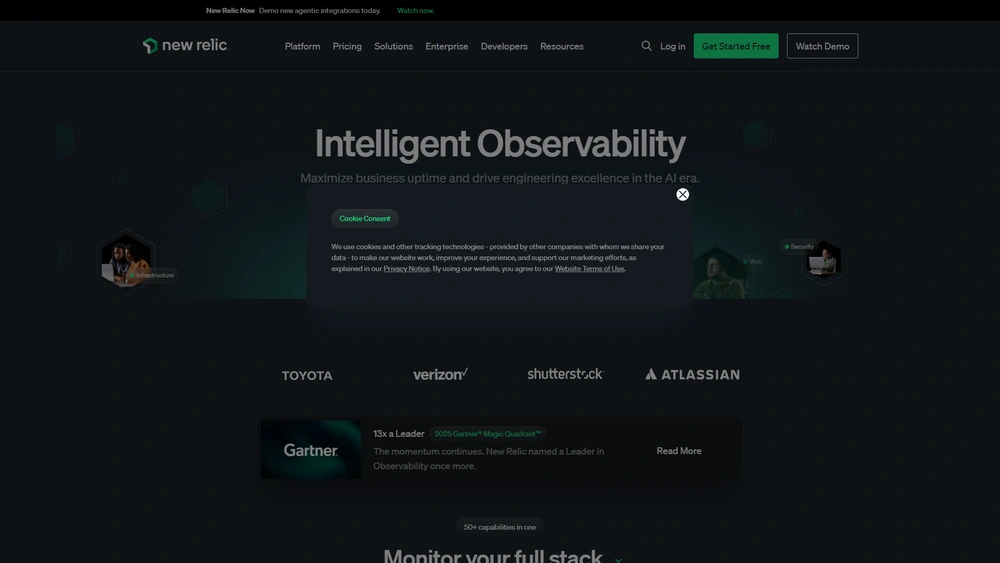New Relic Overview & 2025 Industry Position
New Relic stands at the forefront of the observability and software performance monitoring space in 2025, offering a high-performance cloud platform that merges telemetry data, real-time analytics, and applied intelligence into a flexible usage-based model. Used by engineering teams around the globe—from digital-first startups to Fortune 500 giants—New Relic helps businesses optimize software performance, debug efficiently, and align development goals with business metrics.
In 2025, the brand continues to evolve with a strong focus on enhancing predictive AIOps capabilities and cross-system integrations, responding to the industry need for unifying logs, metrics, and traces in a singular pane of glass. With its intuitive charting, comprehensive dashboards, and open instrumentation philosophy, New Relic provides a strategic advantage in gaining full visibility into software stacks.
From Launch to 2025: New Relic’s Journey
New Relic was founded in 2008 by Lew Cirne with the goal to simplify performance monitoring for developers. By 2013, the company went public on the NYSE under the symbol NEWR. Over the years, notable milestones include:
- 2014: Introduction of the New Relic Software Analytics Cloud.
- 2018: Launch of Distributed Tracing and AI integrations.
- 2020: Revolutionary shift to a usage-based pricing model.
- 2021: Introduction of New Relic One with customizable dashboards.
- 2023: Continued investment in AIOps and OpenTelemetry support.
In 2025, New Relic aims to be the industry’s most open, unified observability platform for proactive performance management across cloud-native and hybrid systems.

New Relic Key Features
New Relic offers deep observability tools surfaced through an intuitive interface. Key capabilities in 2025 include:
- Full-stack Observability: Instrument everything from backend services to frontend behavior.
- APM (Application Performance Monitoring): Advanced tracing, transaction-level detail, and real-time health maps.
- Logs in Context: Correlate log data directly from app code or infrastructure for faster debugging.
- AI/ML-Powered Alerts: Adaptive alert thresholds and anomaly detection with New Relic AI
- Custom Dashboards: Personalized views of performance across any KPIs using NRQL (New Relic Query Language).
- OpenTelemetry-native: Support for standards and seamless ingesting of third-party data streams.
Workflow & UX
New Relic’s UX centers around cohesion: customizable dashboards, embedded query capabilities, and a unified tagging framework let engineering teams slice data however they need with minimal friction. Lightweight agents and out-of-the-box integrations bolster rapid onboarding. From SREs to product teams, the navigation simplifies discovery without sacrificing depth.
New Relic Pricing Analysis & Value Metrics
Current as of July 2025, New Relic offers the following:
| Plan | Monthly Fee | Monthly Data Included | Extra Data | Users |
|---|---|---|---|---|
| Free | $0 | 100 GB | $0.30/GB | 1 Full + Unlimited Basic |
| Standard | $99/User | 1 TB | $0.20/GB | Unlimited |
| Pro | $349/User | 5 TB | $0.15/GB | Unlimited |
| Enterprise | Custom | Unlimited | Volume Pricing | Unlimited |
Value Assessment: The usage-based model democratizes observability, especially with generous data allowances. Teams pay for actual use rather than preemptive overcommitment.
Competitive Landscape
Here’s how New Relic compares against major rivals:
| Platform | Best For | Data Model | Pricing | Key Differentiator |
|---|---|---|---|---|
| New Relic | Full-stack teams | Usage-based | Modular tiers | Unified telemetry + logs |
| Datadog | Advanced analytics teams | Add-on billing | High-volume cost | Large plugin library |
| Dynatrace | Enterprise | Annual licenses | Bundled | Deep AI automation |
| Grafana Cloud | DevOps-centric | Open-source core | Affordable | Visualization workflow |
New Relic’s value rises for teams betting on scalable observability with built-in cost control and out-of-the-box insights.
Top Use Cases
- E-Commerce Performance: Optimize page loads, checkout flow, and uptime for customer conversions.
- SaaS Reliability: Resolve latency spikes, container failures, or DB bottlenecks across multi-cloud deployments.
- Financial Compliance: Document SLAs, investigate anomalies, and trace user interactions end-to-end.
- DevOps Visibility: Seamless CI/CD deployment insights via trace-parent IDs and correlative logs.
New Relic Integrations
New Relic plugs into an expansive ecosystem:
- Cloud Platforms: AWS, GCP, Azure
- Containers & Orchestration: Kubernetes, Docker, Helm
- DevOps Tools: Jenkins, CircleCI, GitHub Actions
- Business Systems: Salesforce, Snowflake, Jira
- Tracing & Logs: Fluentd, OpenTelemetry, Logstash
Pros & Cons
- ✅ Unified Observability: Logs, metrics, traces, and dashboards in one pane.
- ✅ Transparent Pricing: Usage-based model scales fluidly.
- ✅ OpenTelemetry Support: Flexible data sourcing for modern workflows.
- ❌ Learning Curve: NRQL and dashboards require some ramp time.
- ❌ Data Overages: Unexpected ingestion spikes may incur costs.
Pro Tip: Pair New Relic Alerts with anomaly-detection AI to reduce false positives and focus SRE efforts on meaningful thresholds.
Final Thoughts
New Relic in 2025 excels as a full-stack observability platform with unmatched dashboard flexibility, scalable pricing, and extensive integrations. It’s ideal for engineering-first orgs and cloud platforms needing real-time insight without constraints. While there is a moderate learning curve for complex analyses, the power at your fingertips makes this a leading APM solution in any growing digital ecosystem.
New Relic FAQ
New Relic is used for application performance monitoring, infrastructure visibility, log analysis, and system observability to debug, optimize, and scale applications.
Pricing in 2025 is usage-based, with flexible plans including a Free tier (100 GB/month) and scalable Full User pricing for expanded data and integrations.
Yes, New Relic supports full Kubernetes observability with integrations for clusters, pods, workloads, and usage patterns.
It depends on your use case. New Relic offers more unified pricing and flexible data ingestion, while Datadog may provide deeper analytics in large environments.
Absolutely. New Relic is OpenTelemetry-compatible and can ingest logs, traces, and metrics from most major tools including Fluentd, Logstash, and more.